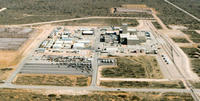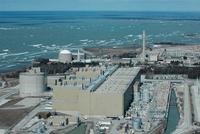-
New Mexico demands clarifications, reassurances on WIPP radiation leaks

New Mexico’s environment secretary Ryan Flynn has ordered the Department of Energy (DOE) to explain how it will protect public health and the environment while it investigates a radiation leak at the underground Waste Isolation Pilot Plant (WIPP). The plant has not been in compliance with various permit requirements since the February underground fire and radiation leak, which eventually led to a plant shutdown.
-
-
Problems continue to plague the Oxide Conversion Facility at Y-12

Oxide conversion is critical to recycling weapons-grade uranium, making it useful in nuclear warheads or for other purposes. The Oxide Conversion Facility (OCF) at the Y-12National Security Complex has been operating inconsistently in recent years. A report by the staff of the Defense Nuclear Facilities Safety Board(DNFSB) said there was a plan to resume operations the week of 7 April 2014, but that did not happen.
-
-
Absorbent used in kitty litter may be cause of radiation leaks in U.S. nuke dump
A wheat-based absorbent often used in kitty litter may be the likely cause of the radiation leak that led to the closure of the Waste Isolation Pilot Plant(WIPP), the U.S. only underground nuclear waste repository, according to Jim Conca, a former geochemist at Los Alamos National Laboratory(LANL). Conca noted that EnergySolutions, a Salt Lake City-based company hired to package radioactive waste at LANL into containers for shipment to the WIPP, switched from using a clay-based absorbent in the storage drums to a wheat-based mixture.
-
-
Lawmakers want safer waste storage at nuclear plants
Lawmakers on Tuesday introduced a set of bills aimed at improving the safety and security of nuclear power plants’ waste in the event of a natural disaster or terrorism. One of the bills would require nuclear power plant operators to accelerate the transfer of nuclear waste stored in spent fuel pools into dry cask storage units. Current Nuclear Regulatory Commission(NRC) regulations allow spent fuel to remain in spent fuel pools until the reactor completes decommissioning, which can take as long as sixty years. Another bill would stop the NRC from issuing exemptions to its emergency response and security requirements for reactors that have been permanently decommissioned.
-
-
Leaders of Chinese city delay alerting residents to deadly radiation risk
Authorities in the East China city of Nanjing delayed,for thirty-six hours, notifying residents about the loss of deadly isotope iridium-192 pellets at a local industrial plant. The pellets disappeared on Wednesday, and plant officials informed government authorities on Thursday – but did not inform city residents until Saturday. The extremely toxic pellets, the size of beans, were found the following Saturday in an open field one kilometer from the plant. The plant management detained four employees at the plant on Sunday for violating radioactive work regulations and storage rules, and they are likely to face criminal charges.The plant is using the isotope to find flaws in metal components.
-
-
Bolstering shipping security
During a press conference following the March 2014 Nuclear Security Summit in the Hague, President Barack Obama noted that his biggest security concern was not Russia — or any other regional superpower — but rather “the prospect of a nuclear weapon going off in Manhattan.” Experts say that the most likely way in which a nuclear weapon would potentially come to a major U.S. city is not on the tip of a missile but in the belly of a ship, noting that this view has been openly validated by the intelligence community. In 2007, Congress passed a law requiring all overseas cargo containers to be inspected before they are loaded on a U.S.-bound ship. That law, however, has never been enforced.
-
-
South Carolina withdraws MOX lawsuit against DOE, NNSA
The state of South Carolina said Friday that it would not go ahead with its lawsuit against the Department of Energy and the National Nuclear Security Administration (NNSA) in support of the Savannah River Site’s Mixed Oxide (MOX) Fuel Fabrication Facility. The dismissal of the lawsuit follows an announcement last Tuesday by the DOE and NNSA that construction will continue on the MOX facility through the end of the fiscal year. The two agencies made it clear, though, that they still plan to mothball the plant.
-
-
Lawmakers want DOE to reduce run-away costs of S.C. plutonium processing plant
Lawmakers have given the Obama administration two weeks to submit a plan for reducing the cost of constructing the mixed-oxide fuel conversion (MOX) facility which would convert bomb-grade plutonium into nuclear fuel. The MOX facility at the Savannah River Site, South Carolina was launched to help the United States meet its nuclear arms reduction agreement with Russia, and agreement which called for the two countries to dispose of at least thirty-four metric tons each of weapons-grade plutonium.
-
-
Lawmakers urge NRC not to exempt shut-down nuclear plants from emergency, security regulations
Lawmakers are urging the U.S. Nuclear Regulatory Commission (NRC) to halt exemption of recently- shuttered nuclear power plants from emergency-planning and security regulations. The lawmakers are especially concerned about the nuclear waste which will continue to be stored on the grounds of shut-down nuclear plants, saying that the stored radioactive waste continues to be a security threat whether or not the plant itself is still operational.
-
-
Birds in and around Chernobyl's exclusion zone adapting to ionizing radiation

Birds in the exclusion zone around Chernobyl are adapting to — and may even be benefiting from — long-term exposure to radiation, ecologists have found. The study is first evidence that wild animals adapt to ionizing radiation, and the first to show that birds which produce most pheomelanin, a pigment in feathers, have greatest problems coping with radiation exposure.
-
-
Threats from insiders are the most serious security challenges nuclear facilities face

Insider threats are the most serious challenge confronting nuclear facilities in today’s world, a new study says. In every case of theft of nuclear materials where the circumstances of the theft are known, the perpetrators were either insiders or had help from insiders, the study found. Theft is not the only danger facing facility operators; sabotage is a risk as well, the study authors say.
-
-
S.C. fights to keep costly plutonium processing project alive
The United States and Russia have agreed to dispose of thirty-four tons of weapon-grade plutonium each, an amount equal to 17,000 nuclear warheads. The United States budgeted $4 billion for a mixed-oxide fuel project, known as MOX, at the Savannah River Site, S.C., to process the plutonium, but construction costs have now reached $8 billion, and officials estimate the facility will cost about $30 billion over its operating years. DOE has suspended the MOX project and is looking for alternative plutonium processing methods. South Carolina has sued the federal government, arguing that since Congress has authorized the funds for MOX, the administration must spend the money.
-
-
Some see small modular reactors as offering a better future for the nuclear industry
A full-size reactor costs up to $8 billion, takes years to build, and decades to achieve a return on investment. Some experts say the future of the nuclear industry should be based on small underground reactors, which are cheaper and quicker to build. Other experts say that smaller reactors mean needing many more of them to produce the same amount of power as traditional reactors, and having more reactors means increasing security concerns.
-
-
Detecting and defeating radiological threats
Brookhaven National Laboratory’s Radiological Assistance Program (RAP) team works to stay ahead of any radiological threats by using many detection tools that have become increasingly sophisticated and user-friendly. During a deployment, researchers and technicians with backgrounds in various aspects of radiological controls and analysis conduct field monitoring and environmental sampling, assessment, and documentation activities to help decision makers choose appropriate protective actions for the safety of both the public and first responders.
-
-
Debate over Ontario, Canada underground nuclear waste facility intensifies

Ontario Power Generation’s (OPG) proposal to construct an underground nuclear waste disposal facility near the company’s Bruce Nuclear plantand on the edge of the Great Lakes is facing growing opposition from local municipalities and environmentalists. The facility would store low and intermediate nuclear waste from OPG’s Bruce, Pickering, and Darlington nuclear facilities. Environmentalists are concerned that a leak in the underground facility would be devastating for communities which depend on water from the Great Lakes.
-
- All
- Regional
- Water
- Biometrics
- Borders/Immig
- Business
- Cybersecurity
- Detection
- Disasters
- Government
- Infrastructure
- International
- Public health
- Public Safety
- Communication interoperabillity
- Emergency services
- Emergency medical services
- Fire
- First response
- IEDs
- Law Enforcement
- Law Enforcement Technology
- Military technology
- Nonlethal weapons
- Nuclear weapons
- Personal protection equipment
- Police
- Notification /alert systems
- Situational awareness
- Weapons systems
- Sci-Tech
- Sector Reports
- Surveillance
- Transportation
Advertising & Marketing: advertise@newswirepubs.com
Editorial: editor@newswirepubs.com
General: info@newswirepubs.com
2010-2011 © News Wire Publications, LLC News Wire Publications, LLC
220 Old Country Road | Suite 200 | Mineola | New York | 11501
Permissions and Policies
Editorial: editor@newswirepubs.com
General: info@newswirepubs.com
2010-2011 © News Wire Publications, LLC News Wire Publications, LLC
220 Old Country Road | Suite 200 | Mineola | New York | 11501
Permissions and Policies
